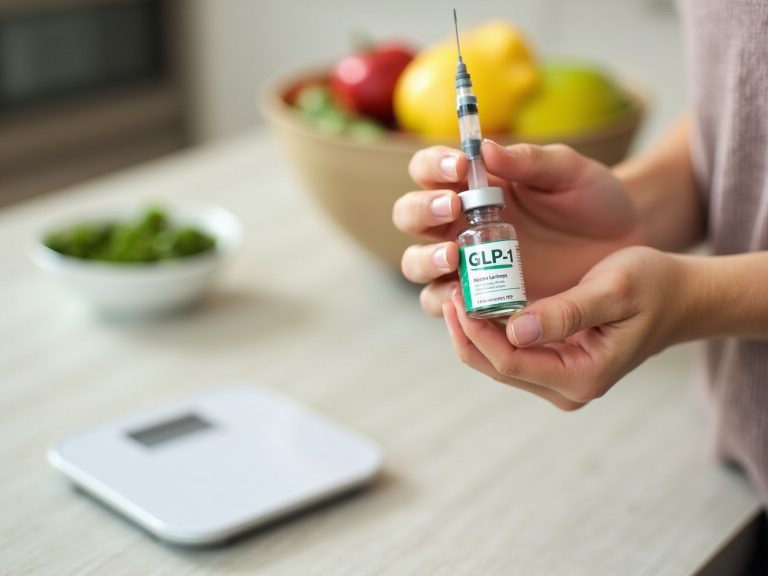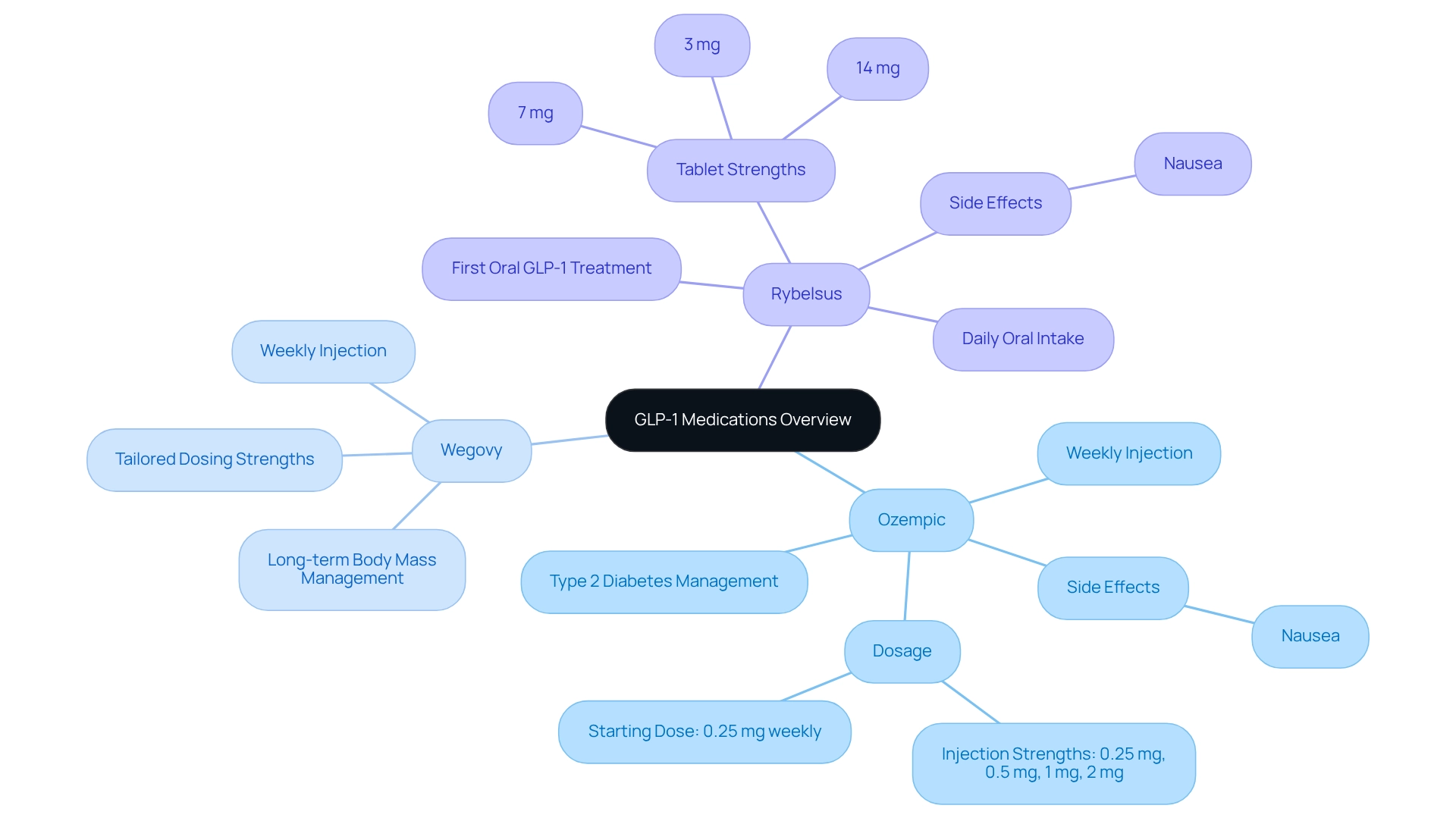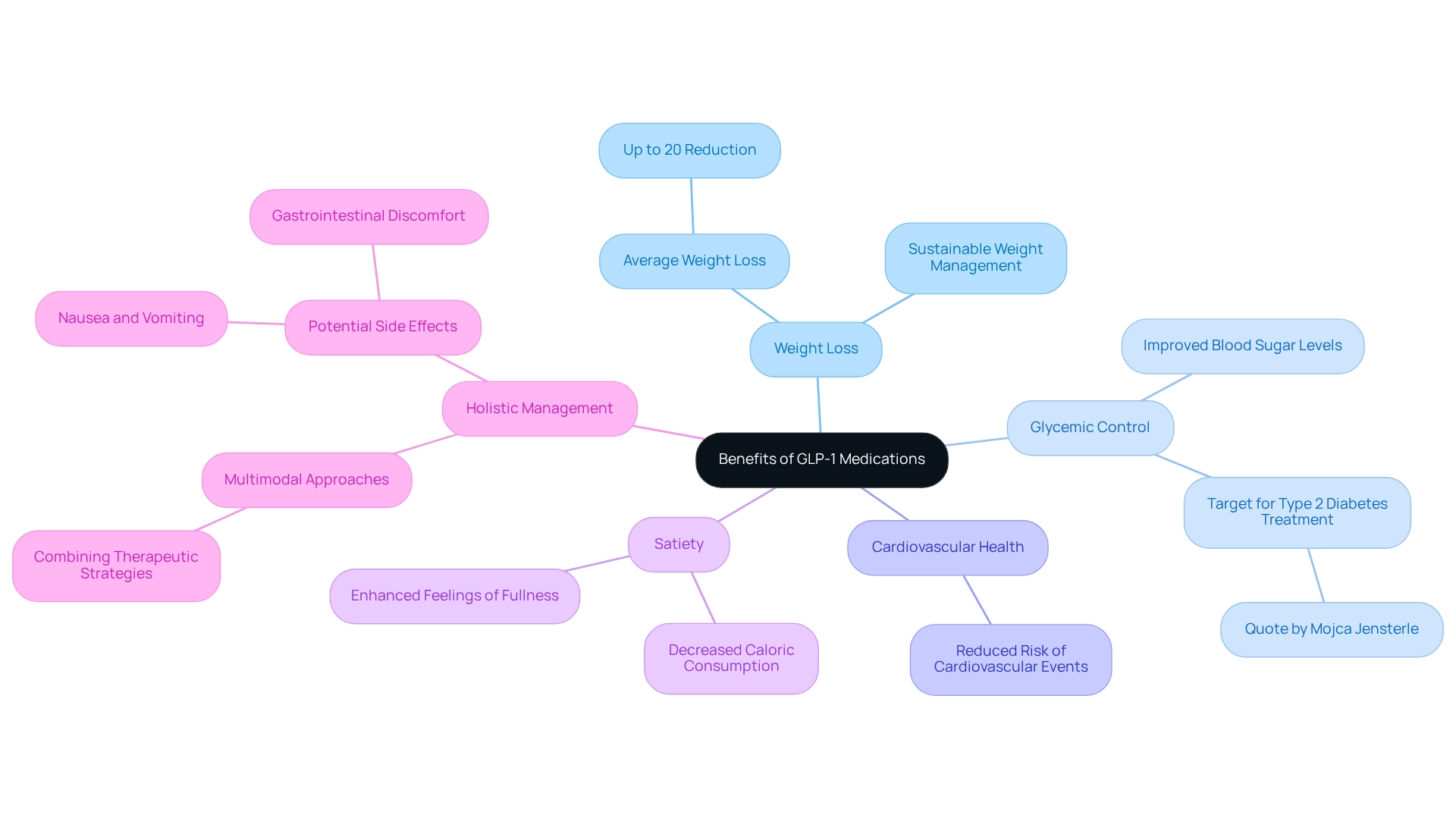Overview
GLP-1 medications, also known as glucagon-like peptide-1 receptor agonists, are here to support you in managing Type 2 diabetes and your weight loss journey. By mimicking the hormone that regulates glucose metabolism and appetite, these medications can play a vital role in your health. Have you been feeling overwhelmed by your weight loss efforts? You’re not alone, and we’re here for you.
These medications have shown great effectiveness in lowering blood sugar levels and promoting significant weight loss. However, it’s essential to consider potential side effects and the importance of personalized treatment approaches. Together, we can find the best path for your unique needs, ensuring optimal health outcomes.
As you explore the possibilities of GLP-1 medications, remember that you deserve a supportive plan tailored just for you. Your journey is important, and with the right tools and guidance, achieving your goals is within reach. Let’s take this step together and embrace the support that’s available to you.
Introduction
In the battle against Type 2 diabetes and obesity, GLP-1 medications have emerged as true game-changers, offering hope and tangible results for millions. These innovative drugs, designed to mimic the natural hormone GLP-1, not only help regulate blood sugar levels but also promote significant weight loss by enhancing satiety and reducing appetite. As more individuals face these challenges, the interest in GLP-1 therapies continues to grow, with studies indicating impressive weight reductions of up to 20% among users.
However, while the benefits are substantial, it’s essential to understand the potential side effects and risks associated with these treatments. This understanding is crucial for anyone considering them. This article delves into the mechanisms, benefits, and future of GLP-1 medications, providing a comprehensive overview of how they can transform health outcomes for individuals struggling with obesity and diabetes. Together, we can navigate this journey towards better health and well-being.
Understanding GLP-1 Medications: An Introduction
Glucagon-like peptide-1 receptor agonists play a vital role in managing Type 2 diabetes and supporting weight loss. These medications mimic the naturally occurring hormone that helps regulate glucose metabolism and appetite. By promoting insulin release and reducing glucagon production, they effectively lower blood sugar levels while fostering a sense of fullness.
This dual action is particularly valuable in tackling the intertwined challenges of obesity and diabetes. As we look ahead to 2025, the prevalence of Type 2 diabetes and obesity in the United States remains alarmingly high, impacting millions. Recent statistics reveal a significant rise in the use of specific medications for weight loss, reflecting a growing recognition of their effectiveness. Studies indicate that patients using receptor agonists, including Compounded Tirzepatide, can achieve remarkable weight loss, with many individuals reporting reductions of up to 20% of their body mass within six months.
Moreover, receptor agonists are seen as beneficial when the likelihood of overall wellness benefit reaches a minimum of 0.60, underscoring their effectiveness in treatment.
The benefits of these therapies extend beyond weight loss; they also contribute to improved cardiovascular health and metabolic function. Ongoing monitoring and evaluation of the benefit-harm ratio of these treatments are essential as new information emerges, highlighting the importance of adhering to prescribed therapies for long-term wellness. As Ezekiel J. Emanuel, MD, PhD, points out, insufficient adherence to treatment may limit the long-term health benefits, such as reduced cardiovascular risk associated with GLP-1 RA therapy.
Recent studies underscore the increasing public interest in GLP-1 agonists, particularly products like Ozempic and Wegovy. A study analyzing search trends from August 2023 to August 2024 revealed that Ozempic garnered the highest relative search volume, showcasing its popularity as a weight loss solution. This trend is echoed globally, with significant interest observed in countries like Canada, the USA, and Australia.
However, it is crucial to understand the potential side effects associated with these treatments. Common side effects may include stomach discomfort, nausea, and diarrhea, which can impact adherence to treatment. Rare but serious conditions, such as lactic acidosis, may arise if the medications are not used appropriately.
Thus, a comprehensive understanding of both the benefits and drawbacks is vital for anyone considering these medications as part of their weight loss journey.
Experts emphasize the essential role of these therapies in managing body weight and diabetes. With robust evidence supporting their effectiveness, receptor agonists, including Minimal’s personalized wellness solutions starting at $99.99/month, are increasingly viewed as a cornerstone in treating obesity and Type 2 diabetes. Minimal’s comprehensive approach to weight loss ensures that individuals receive tailored support throughout their wellness journey.
How GLP-1 Medications Work: Mechanisms of Action
If you’re feeling overwhelmed by your weight loss journey, you’re not alone. Treatments like Mounjaro, Ozempic, and Wegovy offer valuable insights into GLP-1 medications, which can significantly aid in weight control and support your metabolic wellness. These medications work by stimulating insulin secretion in response to food intake, a crucial factor in regulating blood sugar levels. By slowing gastric emptying, they help stabilize postprandial blood glucose levels, preventing those frustrating spikes that can lead to increased hunger and overeating.
Moreover, GLP-1 drugs engage with the brain’s hunger centers, effectively reducing appetite and promoting a satisfying feeling of fullness. This can be a game-changer in your weight loss journey.
Research shows that these medications not only help shed pounds but also enhance cardiovascular health by lowering the risk of heart disease, a common complication associated with diabetes. For instance, individuals using Ozempic or Wegovy have reported an impressive average reduction of 15-20% in weight over the course of a year, highlighting the effectiveness of these treatments. Additionally, Mounjaro is noted for improving insulin sensitivity and controlling cravings, paving the way for sustainable weight loss when paired with a balanced diet and regular exercise.
However, it’s essential to be aware of potential side effects associated with GLP-1 medications. Common side effects may include:
- Nausea
- Vomiting
- Diarrhea
- Bloating
- Injection site reactions, such as swelling or discomfort
Mild fatigue or upset stomach might also occur. While these side effects can be more pronounced at the beginning of treatment, many find that they diminish over time.
A recent study emphasized that efinopegdutide demonstrated greater effectiveness in lowering liver fat levels compared to semaglutide after 24 weeks of treatment. This illustrates the potential of these medications in addressing metabolic disorders. Case studies, like ‘GIP and GLP-1 Effects on Lipid and Glucose Metabolism,’ have shown how this hormone plays a vital role in regulating lipid and glucose metabolism, underlining its direct and indirect effects on adipose and hepatic tissues. These findings reinforce the importance of this hormone in maintaining metabolic balance, further supporting its use in management strategies for body mass.
As Matthias Tschöp observed, the development of dual and triple agonist medications marks significant progress in this field. Overall, treatments like those provided by Minimal represent a promising avenue for individuals seeking effective solutions for weight loss and improved metabolic health. Remember, together, we can achieve your goals, and we’re here for you every step of the way.
Types of GLP-1 Medications: A Comparative Overview
Navigating the world of weight management and diabetes can feel overwhelming, but you are not alone. The market offers several medications, particularly Ozempic, Wegovy, and Rybelsus, each designed to support specific therapeutic needs.
- Ozempic is primarily used for managing Type 2 diabetes.
- Wegovy is specifically approved for long-term body mass management, making it an ideal choice for those focused on shedding pounds.
- Rybelsus, on the other hand, stands out as the first oral GLP-1 treatment, providing a convenient option for patients who prefer to avoid injections.
Understanding the dosing frequency can be crucial in your journey.
- Ozempic is administered as a subcutaneous injection once a week.
- Rybelsus is taken orally every day.
- Wegovy also follows a weekly injection schedule, similar to Ozempic, but with tailored dosing strengths for weight management.
The key differences between Rybelsus and Ozempic lie in their forms and administration schedules:
- Rybelsus is available in tablet strengths of 3 mg, 7 mg, and 14 mg, starting at 3 mg daily.
- Ozempic comes in injection strengths of 0.25 mg, 0.5 mg, 1 mg, and 2 mg, beginning with a 0.25 mg weekly dose.
These distinctions are vital for healthcare providers when determining the most suitable treatment for you.
Efficacy varies among these medications, with clinical trials revealing that nearly one-fifth of patients using Ozempic and Rybelsus reported experiencing nausea, a common side effect of GLP-1 treatments. This statistic highlights the importance of monitoring side effects during your treatment journey. Importantly, no significant differences in safety and efficacy have been observed in patients aged 65 and older, suggesting that these treatments can be safely prescribed across various age groups.
Recent insights from healthcare professionals emphasize the need to understand the nuances between these medications. Julie Adkison, PharmD, BCACP, CDCES, notes, “What is GLP-1 medication? There are several GLP-1 agonist drugs available.” Most are authorized to manage Type 2 diabetes, while others are specifically approved for weight loss. This distinction is essential, as both Ozempic and Wegovy have demonstrated significant effectiveness in weight management, and understanding their specific indications can guide your therapy choices.
Pharmacists play a crucial role in identifying potential drug-drug interactions and collaborating with doctors to enhance patient outcomes in semaglutide treatment. This collaboration underscores the need for a personalized approach to prescribing these medications.
At Minimal, we understand that incorporating GLP-1 treatments into a customized weight loss strategy can significantly enhance your results. These treatments can be complemented by our holistic wellness solutions, including nutrition advice and fitness programs, to create a comprehensive approach to managing body mass. Overall, the comparative analysis of Ozempic, Wegovy, and Rybelsus reveals key differences in their uses, dosing frequencies, and side effects, emphasizing the importance of personalized care in managing diabetes and weight-related health challenges. Together, we can achieve your goals and improve your well-being.
Benefits of GLP-1 Medications: Weight Loss and Beyond
When considering what GLP-1 medication entails, treatments like Wegovy present a range of advantages that extend well beyond mere fat reduction. Clinical studies indicate that patients utilizing these treatments can achieve an average reduction of up to 20% of their initial body mass, based on data from over 70,000 individuals who have engaged for at least six months, with some even experiencing greater decreases. This significant weight loss is often accompanied by improvements in glycemic control, which is crucial for effectively managing type 2 diabetes.
Recent cardiovascular health studies from 2025 reveal that certain treatments not only lower blood sugar levels but also reduce the risk of cardiovascular events. This makes them an essential component in managing patients with obesity and related conditions. Isn’t it reassuring to know that these medications can offer such comprehensive benefits?
Moreover, the impact of these medications on satiety is noteworthy; they enhance feelings of fullness, leading to decreased caloric consumption. This mechanism is particularly advantageous for individuals grappling with obesity, as it supports sustainable weight management. Wegovy, in particular, exemplifies what GLP-1 medication is by mimicking the function of the hormone glucagon-like peptide-1, which plays a vital role in appetite control and food consumption.
Expert insights underscore the importance of GLP-1 medication in holistic obesity management strategies. For instance, a recent case study titled “Multimodal Approaches in Obesity Management” highlights the effectiveness of combining GLP-1 therapy with other treatment methods to amplify weight loss results. Mojca Jensterle from the Department of Endocrinology, Diabetes and Metabolic Disease at University Medical Centre Ljubljana notes, “A significant reduction in body weight should be seen as a target for treatment of type 2 diabetes.”
Success stories abound, with many patients sharing transformative outcomes after incorporating Wegovy into their wellness routines. However, it’s important to recognize that significant shortages of these drugs may affect patients’ access to their prescribed treatments. These treatments not only assist in shedding pounds but also promote overall well-being, potentially decreasing the frequency of certain cancers.
As the landscape of obesity treatment evolves, Wegovy stands out as a powerful ally in achieving lasting health transformations, aligning seamlessly with Minimal’s holistic approach to personalized weight loss solutions and comprehensive health care. It’s essential to be aware of potential side effects, which may include nausea, vomiting, and gastrointestinal discomfort. Following the recommended administration method of a subcutaneous injection once a week, using a pre-filled pen, can make the process easier for you. Together, we can navigate this journey towards better health.
Side Effects and Risks of GLP-1 Medications: What to Know
These treatments, including those offered through Minimal’s tailored weight loss programs, are generally well-received, yet they may lead to side effects, particularly digestive issues such as nausea, vomiting, and diarrhea. It’s important to understand that these symptoms are common during the initial stages of treatment but usually diminish as the body adjusts to the medication. In fact, real-world data shows that while these gastrointestinal side effects are frequent, they often resolve within a few weeks of consistent use.
However, we must also be aware of the serious risks associated with this therapy. There have been reports linking these medications to pancreatitis and potential thyroid tumors, highlighting the need for careful patient selection and ongoing monitoring by healthcare providers. A thorough examination of adverse occurrences related to receptor agonists emphasizes the importance for healthcare providers to stay informed about these risks, especially as the field of obesity treatment evolves.
Statistics indicate that in instances of GLP-1 receptor agonist overdose, severe nausea and vomiting were observed, yet hypoglycemia did not occur even at doses as high as 72 mg. This information underscores the necessity for healthcare providers to access reliable, evidence-based resources for effective treatment management, including dose titration and monitoring for side effects. The significance of having such resources is further illustrated in a case study titled ‘The Importance of Having an Evidence-Based Resource for Pharmacists and Patients,’ which delves into the complexities of therapy management and the crucial role of knowledgeable patient counseling.
Moreover, expert opinions stress the importance of understanding these risks before starting therapy. Professor Moses Elisaf has emphasized the need to be aware of the possible negative impacts linked to this treatment, which enhances the reliability of the information provided. As side effects in individuals using these medications remain a topic of discussion, it is essential for patients to engage in open conversations with their healthcare providers to ensure a safe and effective treatment journey.
Minimal’s unique combination of support, effective therapies, and focus on long-term wellness positions it as a leader in the wellness sector, making it an excellent partner for individuals navigating the complexities of specific therapy. Together, we can achieve your goals and foster a healthier future.
Who Can Benefit from GLP-1 Medications? Eligibility Criteria
These compounds are primarily recommended for adults diagnosed with Type 2 diabetes and those dealing with obesity, particularly individuals with a body mass index (BMI) of 30 or higher. Moreover, these treatments may also be suitable for individuals with a BMI of 27 or above who are experiencing weight-related medical issues, such as hypertension or dyslipidemia. Recent statistics indicate that approximately 36.2 million individuals with employer-sponsored insurance may qualify for certain medications based solely on an obesity diagnosis, highlighting the potential reach of these treatments.
To truly understand what GLP-1 medication is, it’s important to recognize that eligibility for this therapy requires a thorough evaluation by a healthcare professional. This assessment will consider individual wellness profiles to determine the therapy’s suitability. This personalized approach is crucial, ensuring that patients receive specialized care tailored to their unique wellness needs. As Dr. Chance Miller emphasizes, “Clients appreciate the personalized attention from a dedicated care team, which includes physicians like Dr. Chance Miller, who emphasize transformative care.”
Minimal’s holistic strategy, which includes compounded Tirzepatide, has supported many individuals on their wellness journeys. Positive testimonials from satisfied customers, such as Deborah N., who expressed her admiration for the Axiofit product and the comprehensive support she received, reflect this success.
Recent advancements have also shown that the endorsement of a specific medication for heart disease in overweight individuals could expand access to over 3 million Medicare beneficiaries. However, disparities in coverage for diabetic individuals still exist. Real-world examples reveal the benefits of this therapy, with numerous patients achieving significant weight loss and improved health outcomes. Yet, affordability remains a significant concern; a survey found that 54% of GLP-1 drug users face challenges in covering costs, even with insurance.
This situation underscores the need for ongoing discussions about policy reforms to enhance access to these vital treatments. Additionally, the FDA has issued warnings about compounded Semaglutide formulations due to reported adverse events, highlighting safety concerns associated with these medications. Overall, these therapies represent a hopeful option for individuals seeking effective management solutions, provided they meet the established eligibility criteria. Remember, we’re here for you, and together, we can achieve your goals.
Current Trends and Research on GLP-1 Medications
Recent research highlights a significant increase in the appeal of GLP-1 therapies, particularly for those navigating their body mass management journey. This surge has led to many inquiries about what GLP-1 medication entails, reflecting Minimal’s commitment to personalized fat loss solutions. In fact, data reveals that the initiation of anti-obesity treatments (AOMs) rose by 21.1% from September to December 2023, showcasing a growing recognition of their benefits. These medications not only support weight reduction but also promote metabolic health and reduce cardiovascular risks—key components of Minimal’s holistic wellness approach.
Moreover, current clinical trials are delving into new therapeutic applications for these medications, including their potential in addressing neurodegenerative disorders and enhancing mental well-being. This expanding research underscores the versatility and crucial role of treatments like GLP-1 medication in today’s healthcare landscape, as they continue to evolve to meet various health needs. Dr. Chance Miller shares, “Clients truly value the personalized support from our dedicated care team at Minimal, which includes physicians like myself who prioritize transformative care.”
However, we understand that affordability remains a significant concern. A case study titled “Affordability Challenges for Certain Medications” reveals that nearly half of adults who have utilized these treatments struggle with the costs. It’s important to acknowledge these challenges as we strive to find solutions together.
Additionally, patient characteristics based on dispense status and age reveal important demographics of those using these treatments. Notably, the strongest correlation between prescriptions and online search interest was observed for semaglutide and tirzepatide, indicating a rising public curiosity and awareness about these options. Together, we can navigate these developments and work towards achieving your health goals.
The Future of GLP-1 Medications: Innovations and Research Directions
The future of these drugs is exceptionally promising, driven by ongoing studies aimed at enhancing their effectiveness and broadening their applications. Innovations like oral formulations and combination therapies with other weight-loss agents are currently being explored. These advancements could significantly improve patient adherence and outcomes, offering hope to many on their weight loss journey. Recent studies highlight the potential of receptor agonists not only in managing body mass but also in supporting cardiovascular health and addressing metabolic syndrome. This versatility showcases their ability to treat various medical conditions, which is encouraging.
As researchers delve deeper into the mechanisms of these medications, it becomes increasingly clear that they could play a vital role in comprehensive wellness management strategies. For instance, a landmark study revealed that semaglutide could significantly reduce heart events in overweight or obese patients with a history of heart disease. This underscores its importance in managing cardiovascular risks. Jorge Plutzky, M.D., a cardiologist at Mass General Brigham, noted that this study could mean a brighter future for large numbers of patients with heart disease, which is truly inspiring.
Moreover, innovative models suggest that starting with GLP-1 receptor agonists (GLP-1RAs) for weight loss could be followed by transitioning to more affordable interventions for maintenance. This approach, as highlighted in the case study ‘Alternative Maintenance Strategies,’ aims to improve access to effective weight control options while reducing long-term medical expenses. It’s a thoughtful solution that could benefit many.
Looking ahead to 2025, we anticipate that exploring new research avenues for certain therapies will provide valuable insights into their applications for various medical conditions. This ongoing advancement in GLP-1 therapies reflects a commitment to enhancing patient outcomes and emphasizes the transformative potential of these treatments in health management. Data from over 70,000 patients who participated for at least six months is being utilized to measure success, further highlighting the effectiveness of GLP-1 medications. Together, we can achieve your goals and make strides towards a healthier future.
Conclusion
GLP-1 medications offer a transformative approach to managing Type 2 diabetes and obesity, providing benefits that go beyond just weight loss. By mimicking the natural hormone GLP-1, these medications help regulate blood sugar levels and promote a sense of fullness, leading to significant weight reductions—often up to 20% of body weight among users. Their positive impact on cardiovascular health highlights their vital role in comprehensive treatment strategies for those facing the challenges of obesity and diabetes.
However, it’s essential to be aware of potential side effects. Many users tolerate GLP-1 medications well, but common issues like gastrointestinal discomfort can occur, especially during the initial stages of treatment. Although serious risks are rare, they require careful patient selection and ongoing monitoring by healthcare professionals. Open discussions between patients and providers are crucial to navigate the complexities of this therapy effectively.
Looking ahead, the future of GLP-1 medications is promising, with ongoing research leading to innovative formulations and broader applications, including potential uses in cardiovascular health and neurodegenerative diseases. As interest and accessibility continue to grow, these medications are set to play a pivotal role in enhancing health outcomes for millions. By embracing a holistic approach that combines GLP-1 therapy with personalized support, we can embark on a successful journey toward better health and well-being together.
Frequently Asked Questions
What are glucagon-like peptide-1 (GLP-1) receptor agonists and how do they work?
GLP-1 receptor agonists are medications that mimic a natural hormone to help regulate glucose metabolism and appetite. They promote insulin release and reduce glucagon production, leading to lower blood sugar levels and a sense of fullness.
What role do GLP-1 receptor agonists play in managing Type 2 diabetes and weight loss?
These medications are vital in managing Type 2 diabetes and supporting weight loss by addressing the interconnected challenges of obesity and diabetes, leading to effective blood sugar control and significant weight loss.
How effective are GLP-1 receptor agonists in terms of weight loss?
Studies indicate that patients using GLP-1 receptor agonists, such as Compounded Tirzepatide, can achieve weight loss of up to 20% of their body mass within six months.
What are the additional health benefits of using GLP-1 receptor agonists?
Beyond weight loss, these therapies contribute to improved cardiovascular health and metabolic function.
What are the common side effects associated with GLP-1 receptor agonists?
Common side effects include stomach discomfort, nausea, diarrhea, and injection site reactions. Mild fatigue or upset stomach may also occur, particularly at the beginning of treatment.
Are there any serious side effects associated with GLP-1 receptor agonists?
Rare but serious conditions, such as lactic acidosis, may occur if the medications are not used appropriately.
What is the importance of adherence to GLP-1 receptor agonist therapy?
Insufficient adherence to treatment can limit long-term health benefits, such as reduced cardiovascular risk, associated with GLP-1 receptor agonist therapy.
What medications are included in the category of GLP-1 receptor agonists?
Notable GLP-1 receptor agonists include Ozempic, Wegovy, and Mounjaro.
How has public interest in GLP-1 receptor agonists changed recently?
There has been a significant increase in public interest, with products like Ozempic experiencing high search volumes as a weight loss solution.
What should individuals consider before starting GLP-1 receptor agonist therapy?
A comprehensive understanding of both the benefits and drawbacks is essential for anyone considering these medications for weight loss.



















